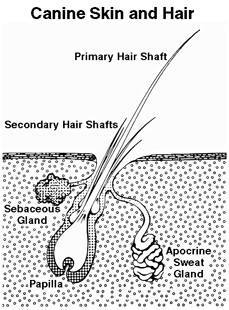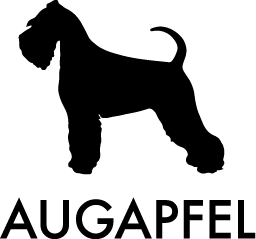Hand stripping can appear hard and we generally don’t recommend owners hand strip their dogs. We use tools and techniques described on other pages on this website. That said, no harm can be done giving it a try and it will make your schnauzer look like it’s ‘showtime’!
The science of hand stripping
The schnauzer is a double-coated dog; there is a harsh, wiry outer coat and a soft undercoat. To understand why we hand strip or use special tools on a schnauzer coat, it sometimes helps to get an understanding of how hair grows and its life-cycle. Don’t be concerned if you’re not that kind of person! If you are interested in the science, read on, otherwise, skip this section.
The canine hair follicle is complex—meaning that they support more than a single hair. The canine hair follicle can contain one to two primary hairs and anywhere from seven to twenty-two secondary hairs also known as undercoat.
Canine hair also grows in different cycles, Anagen, Catagen and Telogen. Anagen is the active growth stage. A hair in this stage can be growing for anywhere from a couple of days to as long as twenty-five years. In the Catagen stage, the bulb starts to constrict and the hair becomes thicker and starts pushing out of the follicle. This then leads to the Telogen stage where the bulb separates from the follicle and a new hair begins to push up next to the old hair. The old hair is eventually shed or in some instances, stripped out.

To maintain a healthy coat, the older hair must be removed and allow the production of new, healthy hair. Schnauzers have thick and coarse primary hairs and softer secondary hairs. Due to the thickness of the hair shaft in schnauzers, they sometimes get stuck because the follicle itself is narrow. When the older hair remains in the follicle and as the new hair grows, the follicle can become irritated and swollen. Often times when schnauzers are clipped and not at least carded (a type of comb that pulls out dead hair), the old hair along with oils and cellular debris can clog the follicle and cause sores and pustules. Only a minimal amount of carding on a clipped schnauzer, followed by a follicular flushing bath, can help prevent follicular clogging and sores.
The technique of hand stripping is simply physically removing the hair by pulling it out of the follicle. Pulling the hair triggers a rapid cellular response and a new hair is stimulated to grow and a coarser and brighter hair is produced. In this process, the new coloured hair becomes darker and the white hair is brighter. The colour in the hair shaft is produced as the new hair grows and the pigments are deposited toward the end of the hair shaft. As it continues to grow, less pigment is deposited and when pulled, the end of the hair shaft appears white. When schnauzers are clipped, the ends of the hair shaft are cut off, removing the pigment and the end of the hair shaft with little to no pigment are left in the follicle giving the dog’s coat a “faded” appearance.
How to Handstrip
The term ‘hand stripping’ refers to removing the hair without cutting or breaking by using your fingers (think of plucking) or replacing your index finger with a stripping knife or a stripping stone.
Every dog’s coat is different in texture and growth rate. Getting a feel for each dog’s coat can take time to learn.
To prepare the coat for stripping, comb the dog’s coat in the direction you wish the coat to lie. By combing the dog’s coat through, you will avoid pulling clumps of hair. Hair that is pulled in clumps will grow back in clumps giving the coat a “patchy” appearance.
Always remember to support the skin by stretching the skin in the opposite direction from the way you are pulling. Then, pulling toward your body, grasp the hair that you desire to pull toward the end of the hair shaft and pull in the direction you with the new hair to grow. Make sure that you are not bending or snapping your wrist as this may cause breaking or cutting the hair. You may use chalk or ear powder on your fingers or on the coat to help absorb excess oil on the coat and help give a better grip on the hair shaft.
Why hand strip?
To maintain a harsh coat, along with healthy skin, dark rich colour and proper texture, the coat must be worked constantly by rolling the coat. When rolling a coat, you are only pulling the dead hair of the outer layer to reveal the idle layer of coat that is at its prime length.
Staging a schnauzer coat
Staging a coat is necessary to prepare for rolling a coat. Since hair grows in cycles and that different hairs in an area may be on different cycles and have different growth rates, hair on different parts of the body grow faster and have a shorter “life span” than others. (Consider the short hairs on the face, ears and neck and longer hairs on the body.)
Staging a coat is a process where you remove the hairs in the areas that you want to be the longest. During all stages, you will want to work the furnishings on the legs underline and face, including eyebrows, to keep several layers going at all times
Stage 1: Strip the areas that you wish to be the longest. This area consists of the back of the neck, down past the withers and into the topline. If your dog has a low tail set, you will want to strip out this area also.
Stage 2: The secondary hairs grow faster than the primary hairs so you will need to “de-fuzz” the area from Stage 1. At this stage, you will want to strip out the coat that you want to be of medium length. You will strip out the sides of the neck, the rest of the body and the hips. Remember to work the furnishings on the legs, face and underline.
Stage 3: De-fuzz the areas from Stages 1 and 2. At this point you will strip out the areas that you want to be the shortest. These areas include the ears, head, throat and the area around the anus and genital area and inside the cowlicks on the rear end. Again, remember to work the furnishings on the legs, face and underline.
Once you have the dog’s coat grown to the ideal length to achieve proper breed profile, you will now begin to roll the coat. First, card the coat to remove excess undercoat and allow the primary hairs to lay flat. Next you will want to remove about one third of the coat remembering to work in a even pattern all over. If you hop around, your new coat will grow in “patches.”
